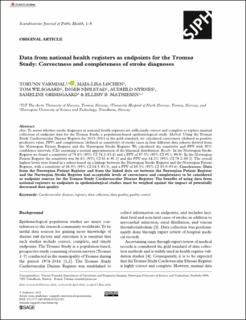| dc.contributor.author | Varmdal, Torunn | |
| dc.contributor.author | Løchen, Maja-Lisa | |
| dc.contributor.author | Wilsgaard, Tom | |
| dc.contributor.author | Njølstad, Inger | |
| dc.contributor.author | Nyrnes, Audhild | |
| dc.contributor.author | Grimsgaard, Sameline | |
| dc.contributor.author | Mathiesen, Ellisiv B. | |
| dc.date.accessioned | 2021-10-26T08:33:23Z | |
| dc.date.available | 2021-10-26T08:33:23Z | |
| dc.date.created | 2021-06-14T12:06:39Z | |
| dc.date.issued | 2021 | |
| dc.identifier.issn | 1403-4948 | |
| dc.identifier.uri | https://hdl.handle.net/11250/2825571 | |
| dc.description.abstract | Aim:
To assess whether stroke diagnoses in national health registers are sufficiently correct and complete to replace manual collection of endpoint data for the Tromsø Study, a population-based epidemiological study.
Method:
Using the Tromsø Study Cardiovascular Disease Register for 2013–2014 as the gold standard, we calculated correctness (defined as positive predictive value, PPV) and completeness (defined as sensitivity) of stroke cases in four different data subsets derived from the Norwegian Patient Register and the Norwegian Stroke Register. We calculated the sensitivity and PPV with 95% confidence intervals (CIs) assuming a normal approximation of the binomial distribution.
Results:
In the Norwegian Stroke Register we found a sensitivity of 79.8% (95% CI 74.2–85.4) and a PPV of 97.5% (95% CI 95.1–99.9). In the Norwegian Patient Register the sensitivity was 86.4% (95% CI 81.6–91.1) and the PPV was 84.2% (95% CI 79.2–89.2). The overall highest levels were found in a subset based on a linkage between the Norwegian Stroke Register and the Norwegian Patient Register, with a sensitivity of 88.9% (95% CI 84.5–93.3), and a PPV of 89.3% (95% CI 85.0–93.6).
Conclusions:
Data from the Norwegian Patient Register and from the linked data set between the Norwegian Patient Register and the Norwegian Stroke Register had acceptable levels of correctness and completeness to be considered as endpoint sources for the Tromsø Study Cardiovascular Disease Register. The benefits of using data from national registers as endpoints in epidemiological studies must be weighed against the impact of potentially decreased data quality. | en_US |
| dc.language.iso | eng | en_US |
| dc.publisher | SAGE | en_US |
| dc.rights | Navngivelse 4.0 Internasjonal | * |
| dc.rights.uri | http://creativecommons.org/licenses/by/4.0/deed.no | * |
| dc.title | Data from national health registers as endpoints for the Tromsø Study: Correctness and completeness of stroke diagnoses | en_US |
| dc.type | Peer reviewed | en_US |
| dc.type | Journal article | en_US |
| dc.description.version | publishedVersion | en_US |
| dc.source.journal | Scandinavian Journal of Public Health | en_US |
| dc.identifier.doi | 10.1177/14034948211021191 | |
| dc.identifier.cristin | 1915557 | |
| cristin.ispublished | true | |
| cristin.fulltext | original | |
| cristin.qualitycode | 1 | |

